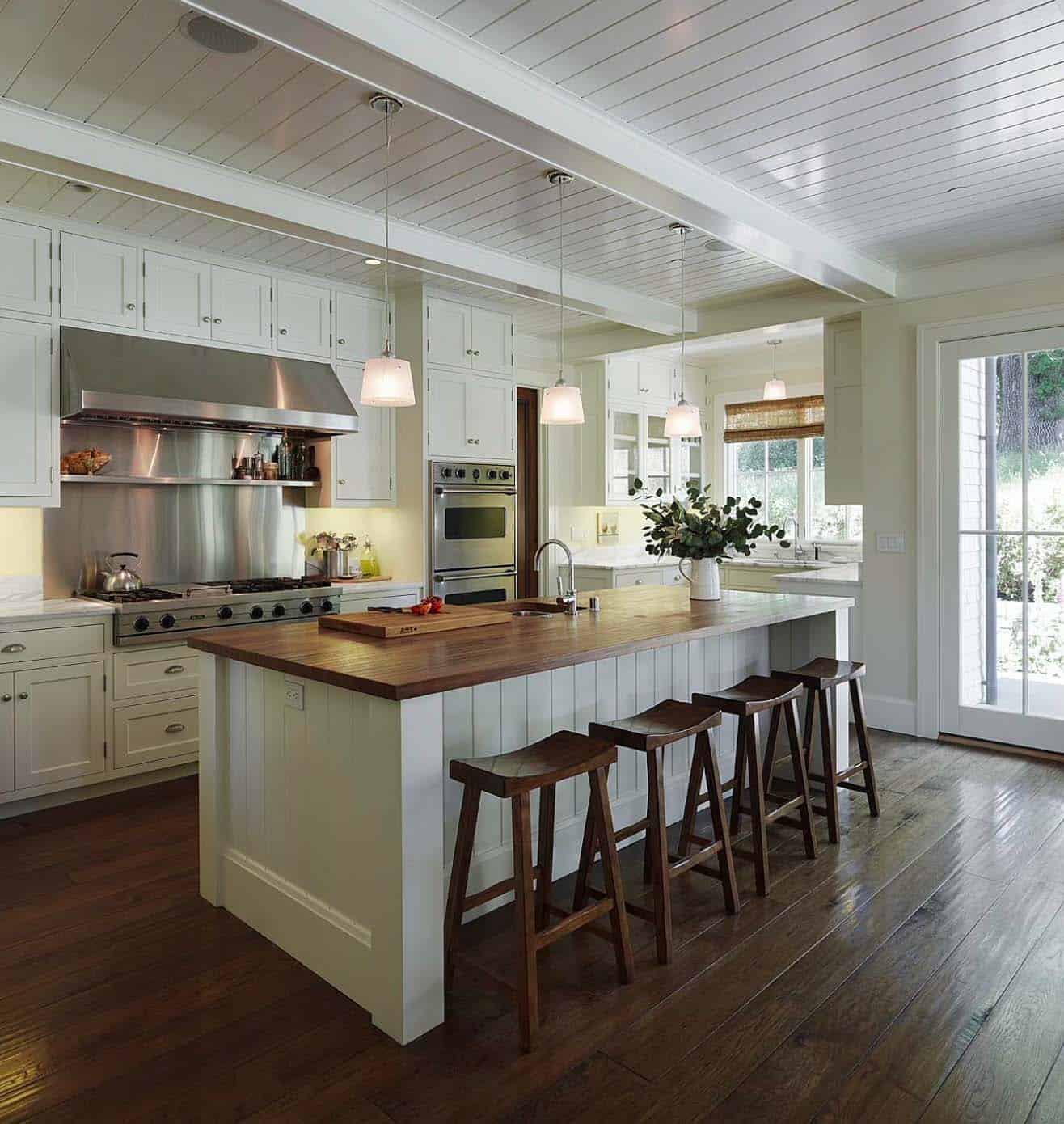Space-Savvy Solutions for Your Dream Kitchen
Not all of us are blessed with expansive kitchens, but that doesn’t mean you have to sacrifice style or functionality. A well-designed kitchen island can be a game-changer, even in a compact space. Let’s explore some clever ideas to maximize your small kitchen’s potential.
Space-Saving Designs That Don’t Skimp on Style
-
Rolling Carts: Your Mobile Command Center: Think of rolling carts as your culinary sidekicks. They provide extra prep space when needed and tuck away neatly when not in use. Perfect for small kitchens where flexibility is key.
-
Overhangs and Breakfast Bars: Doubling Down on Function: Extend your island countertop with an overhang to create a casual dining spot for breakfast, brunch, or even a quick coffee break. It’s like gaining a whole new room without sacrificing precious floor space.
-
Multi-Functional Islands: The Transformers of Kitchen Furniture: These overachievers combine prep space, seating, and storage in one compact design. Imagine chopping veggies, enjoying a quick meal, and storing your favorite cookbooks all in one stylish unit.
Functionality Meets Organization
-
Storage Solutions: A Place for Everything, and Everything in Its Place: Built-in shelves, drawers, and wine racks within your island help you conquer clutter and keep your kitchen organized. Imagine saying goodbye to countertop chaos and hello to a serene and streamlined cooking space.
-
Vertical Storage: Thinking Up, Not Out: When floor space is limited, look up! Installing wall-mounted shelves or using stackable bins above your island capitalizes on vertical space, maximizing storage potential without sacrificing valuable counter area.
-
Optimizing Layout: The Importance of Flow: Before falling in love with an island, visualize how it fits into your kitchen’s flow. Choosing the right size and shape ensures there’s enough room to open appliances, access the fridge, and move around comfortably.
Infusing Personality into Your Design
-
Complementary Rugs: Defining Your Space with Style: A strategically placed rug under your island not only adds a touch of personality but also helps define the kitchen area, especially in open-plan layouts. Choose a rug that complements your island’s vibe, whether it’s modern and sleek or rustic and charming.
-
Decorative Accents: A Touch of You: Adding carefully chosen decorative accents, like potted herbs, colorful cookbooks, or a statement bowl, personalizes your island and makes it feel like the heart of your home. Remember, less is more in a small space, so avoid overcrowding.
Finishing Touches for Maximum Impact
-
Lighting Matters: Setting the Mood and Enhancing Functionality: Pendant lights suspended above the island or under-cabinet lighting add both task lighting and ambiance. Not only do they look stylish, but they also make working in your kitchen a more enjoyable experience.
-
Material Magic: Balancing Style and Durability: The materials you choose for your island’s countertop and cabinetry should be both visually appealing and durable enough to withstand everyday use. Consider options like quartz, granite, or laminate for their resilience and easy-to-clean surfaces.
-
DIY Dreams: Creating a One-of-a-Kind Masterpiece: You don’t need a huge budget to have a stylish island. Repurposing old furniture or using affordable materials allows you to craft a unique island that reflects your personality and complements your kitchen’s aesthetic.
How to Successfully Incorporate an Island in a Small Kitchen
You’ve heard that a kitchen island can be a game-changer, even in a smaller kitchen. But how do you make it work without making your space feel cramped? Let’s dive into some creative solutions:
Rethinking the Traditional Island
First, let go of the notion that islands are exclusive to massive kitchens. Good things come in small packages, and your island can be a stylish and functional addition without overwhelming your space.
Small but Mighty: Compact Islands
These compact wonders are your new best friends. Typically square or rectangular, they tuck neatly into a corner or against a wall, providing extra prep surface and sometimes even storage underneath. Many compact islands are light enough to be moved aside if you need additional floor space.
Wheels of Wonder: Rolling/Portable Islands
These versatile islands are like the Swiss Army knives of the kitchen. On wheels and easy to maneuver, they can be rolled out when needed and tucked away when not in use. Some even come with drop-leaves to expand your work surface or features like towel racks and spice storage.
Double Duty: Multi-Functional Islands
Why have an island that only serves one purpose when it can do it all? Multi-functional islands often incorporate features like dining tables, breakfast bars, or extra storage, maximizing their utility in a small space.
Perfectly Tailored: Built-In Islands
For a truly customized solution, consider a built-in island. These are designed specifically for your kitchen’s layout, making the most of every square inch. While they may require more planning (and potentially, a contractor), the results can be transformative.
Design Secrets for Island Success
-
Shape Shifter: Long, narrow islands are ideal for galley kitchens, adding function without obstructing traffic flow. Square or round islands, on the other hand, soften corners and work well in smaller spaces.
-
Upward Bound: Don’t let vertical space go to waste! Open shelving below your island can house cookbooks or display pretty dishes, while cabinets provide discreet storage.
-
Height Matters: A standard 36-inch countertop is perfect for most prep tasks, but if you envision your island as a gathering spot, a taller, bar-height (42 inches) might be more suitable.
-
Lighten Up: Dark colors tend to make a space feel smaller. Opt for light and bright hues for your island and countertops to visually expand the room.
-
Traffic Controller: Ensure there’s enough clearance (around 36-48 inches) around your island for easy movement. Avoid creating a traffic jam in your kitchen.
Inspiration Awaits
Now that you’re armed with knowledge, it’s time to find the perfect island for your small but mighty kitchen. Browse design magazines, online galleries, kitchen cabinets white and social media for endless inspiration.
You Got This!
Don’t let a small kitchen limit your design dreams.
With a little planning, creativity, and these helpful tips, you can have the kitchen island you’ve always wanted, no matter how much square footage you have to work with.
Are Islands Good for Small Kitchens?
You might think kitchen islands are only for those sprawling kitchens you see in magazines, but they can actually be fantastic additions to smaller kitchens.
Here’s why:
-
Extra Counter Space: Islands provide that much-needed additional work surface, which is essential when preparing meals, especially in smaller kitchens with limited counter space.
-
Ample Storage: Many islands come with built-in drawers, shelves, or cabinets, offering valuable storage solutions for cookware, utensils, and other kitchen essentials. This helps keep your countertops clutter-free and your kitchen organized.
-
Improved Flow: A well-placed island can optimize kitchen traffic flow, creating dedicated zones for prepping, cooking, and cleaning. This can make your kitchen feel less cramped and more efficient.
-
Dining and Socializing: Some islands feature breakfast bars or overhangs, providing a casual dining space or a spot for friends and family to gather while you cook. This can be a great way to maximize space and create a more social kitchen environment.
-
Style Boost: Kitchen islands can elevate the overall design aesthetic of your kitchen, adding a touch of sophistication and visual interest.
However, the key to success is choosing the right island for your space.
Consider these factors:
-
Size and Shape: Opt for a size and shape that fits comfortably in your kitchen without obstructing movement or overwhelming the space.
-
Style: Choose an island design that complements your kitchen’s existing style, whether it’s modern, traditional, farmhouse, or something in between.
-
Functionality: Prioritize features that align with your needs, such as extra storage, seating, or appliance integration.
When done right, kitchen islands can transform even the smallest kitchens into functional and stylish spaces.
What is the Smallest Size for a Kitchen Island?
While there are no hard and fast rules, most designers agree that the absolute minimum size for a functional kitchen island is around 2 feet wide and 4 feet long.
However, several factors influence the ideal size for your specific kitchen:
Factors to Consider:
-
Kitchen Layout: The existing layout of your kitchen (galley, L-shaped, U-shaped, etc.) plays a crucial role in determining what size and shape island will fit best without hindering movement or creating a cramped feel.
-
Desired Functionality: Think about how you plan to use the island. Do you need it primarily for food prep, or are you hoping to incorporate seating, storage, or appliances?
-
Style Goals: Consider the overall style of your kitchen. A chunkier, more rustic island might suit a traditional kitchen, while a sleek and minimalist island would be more fitting in a modern space.
Maximizing a Small Footprint:
If you’ve determined that a small island is the way to go, here are some tips for maximizing its functionality:
-
Think Vertical: Incorporate shelves or cabinets above your island for additional storage, taking advantage of vertical space without sacrificing valuable counter area.
-
Multi-Functional Furniture: Look for islands with built-in seating, pull-out cutting boards, or hidden storage compartments to make the most of a compact design.
-
Get Creative & Customize: Consider repurposing a vintage dresser or console table into a unique and charming island. Or, if you’re handy, explore building your own custom island to perfectly fit your needs and space.
Even a small kitchen island can make a big difference in your kitchen’s functionality and style. With careful planning and a dash of creativity, you can create a focal point that optimizes your space and enhances your cooking experience.










